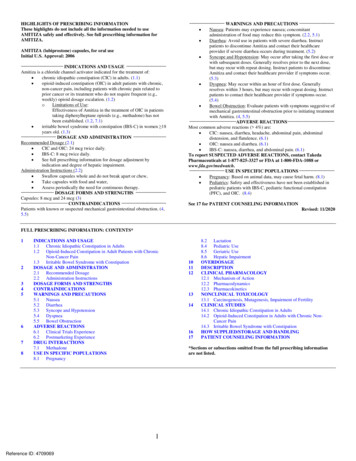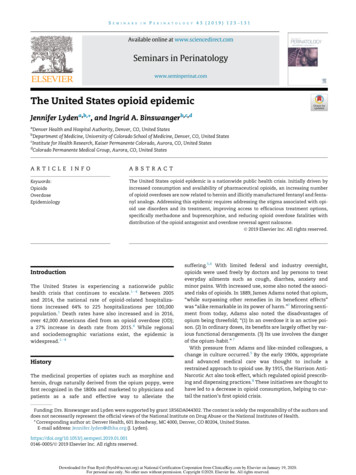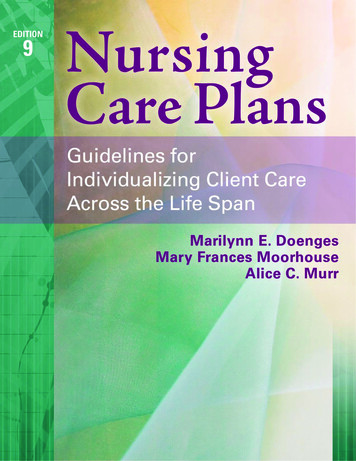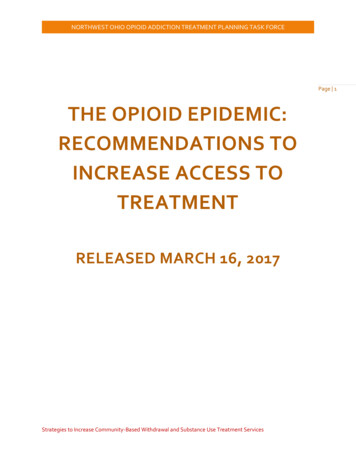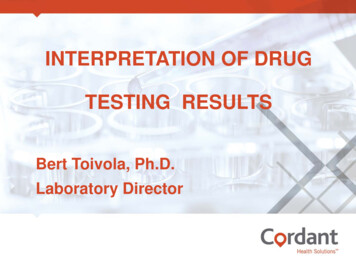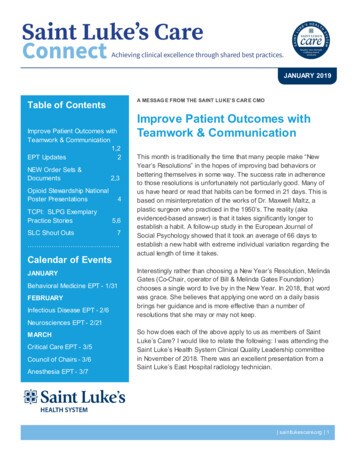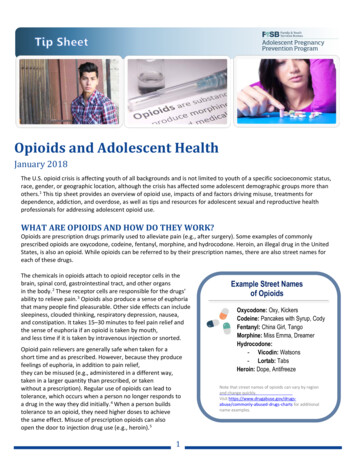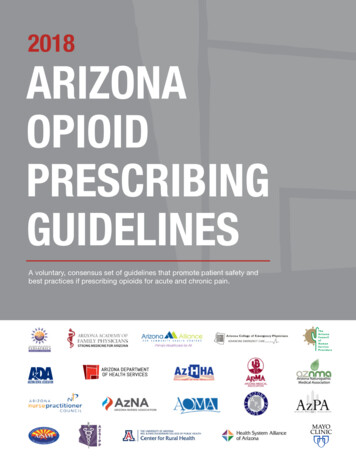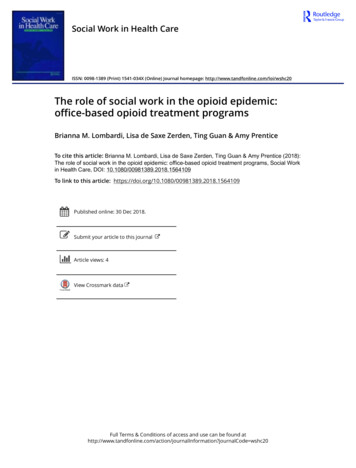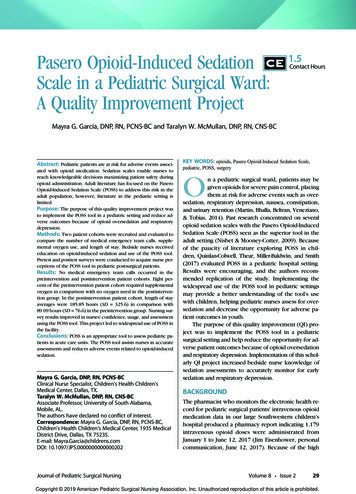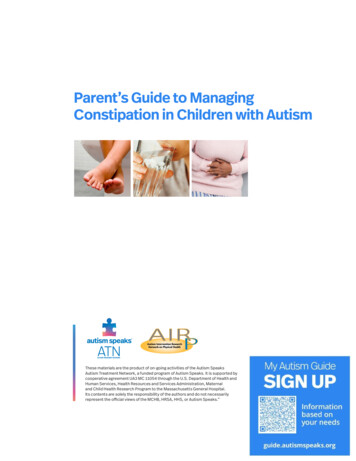
Transcription
MANAGEMENT OFOPIOID-INDUCEDCONSTIPATION1 AMA PRA CATEGORY 1 CREDIT(S) 1 HOUR CATEGORY 2B, AOA3500 CAMP BOWIE BLVD. FORT WORTH, TEXAS 76107-2699PHONE: 800-987-2263 WEB: www.RegisterWithUNT.comCME MONOGRAPHVALID MAY 25, 2009 – MAY 31, 2010
MANAGEMENT OFOPIOID-INDUCEDCONSTIPATIONEducational CONTENT COMMITTEEBruce Chamberlain, MD, FACPIf your Quick ReferenceCard is missing or you needadditional cards, please emailregister@hsc.unt.eduDirector, Palliative ConsultingMedical Director, Sunrise Hospice, Orem, UTDisclosures: Nothing to discloseResolution: N/AGail Austin Cooney, MD, FAAHPMDirector & Medical Director EmeritusSari Asher Center for Integrative Cancer CenterWest Palm Beach, FLPresident Elect - American Academy of Hospice and Palliative MedicineDisclosures: Non-CME Speaker: Honorarium-Wyeth; JPM Supplement: Editorial Stipend – WyethResolution: Input was restricted to reviewing content for clinical accuracy. Input was screenedfor bias by non-conflicted faculty. Bias was not detected.Ricardo Alberto Cruciani, MD, PhDAssociate Professor of Clinical Neurology,The Saul R. Korey Department of NeurologyAssistant Professor, Department of AnesthesiologyAlbert Einstein School of Medicine Yeshiva University, New York, NYDisclosures: Non-CME Speaker: Honoraria – ENDO, Pfizer, Merck; Clinical Trial: ResearchSupport – Cephalon, FRALEX, GW Pharmaceuticals, Abbott; Pain Course Organizer/Speaker– Grupo Ferret (Spain), Laboratories Nolver (Venezuela)Resolution: Input related to pain management and consequences of not treating OIC considered.Other Input screened for bias by non-conflicted faculty. Bias was not detected.Janice A. Knebl, DO, MBA, FACOI, FACP, CMDPARTICIPATION & CREDIT INSTRUCTIONSThere are no fees for participating in or receiving creditfor this educational activity. This activity is designed to becompleted within the time designated on the title page;physicians should only claim those credit that reflect thetime actually spent in the activity. To successfully earn credit,participants must complete the activity during the validcredit period that is noted on the title page.STEPS TO EARN CME/CE CREDIT*:1. Read the learning objectives and author disclosures.2. Study the educational content.3. Choose the best answer to each test questions.4. To receive a certificate, you must complete both theActivity Post Test and Activity Evaluation.You can complete the post test and evaluation onlineat www.RegisterWithUNT.com and receive yourcertificate immediately. Otherwise, please mail orfax the post-test and evaluation to:PACE Office/UNTHSC3500 Camp Bowie Blvd.Fort Worth, Texas 76107FAX: 817-735-2598 PHONE: 800-987-2263Dallas Southwest Osteopathic Physicians’ Endowed Chairin Clinical Geriatrics, Professor of Medicine and Chief, Division of Geriatrics, GeneralInternal Medicine and Endocrinology, Department of MedicineUniversity of North Texas Health Science Center at Fort Worth,TexasDisclosures: Research support – Elan and NovartisResolution: No conflict identified, N/AJudy Lundgren, RN, MSN, AOCN Past President, Oncology Nursing SocietyRadiation Oncology Nurse, Fort Worth,TexasDisclosures: Nothing to discloseResolution: N/ALeeAnne Vandergriff, RN, BSN, OCNOncology Nurse, Fort Worth,TexasDisclosures: Nothing to discloseResolution: N/AChun-Su Yuan, MD, PhDCyrus Tang Professor of Anesthesia & Critical Care Department of Anesthesia &Critical Care Director of the Tang Center of Chinese Herbal Medicine , University ofChicago, Chicago, ILDisclosures: Consulting Fee-WyethResolution: Treatment recommendations restricted to complementary and alternative therapies.Other input screened for bias by non-conflicted faculty. Bias was not detected.
CME MONOGRAPHOBJECTIVESAfter completing this program, participants will be able to:1. Recognize opioid-induced constipation (OIC) as oneof the most common side effects of opioid therapy2. Identify and implement steps to remove barriers toeffectively communicate with patients about OIC andtreatment options3. Determine appropriate prophylactic and preventionmeasures for individual patients4. Employ an evidence-based OIC treatment protocolwhich maintains patient dignity, quality of life and paincontrolPARTICIPATION & CREDITINSTRUCTIONSThere are no fees for participating in or receiving creditfor this educational activity. This activity is designed to becompleted within one hour.steps to earn CME/CEcredit: Read the overview, learning objectives and authordisclosures. Study the educational content. Choose the best answer to each test questions.Record your answers on the credit request form inthe Post-Test Responses box. To receive a certificate, you must complete both theActivity Post Test and Activity Evaluation.You can complete the post test and evaluationonline at www.RegisterWithUNT.com and receiveyour certificate immediately. Otherwise, pleasemail or fax the post-test and evaluation to:PACE Office/UNTHSC3500 Camp Bowie Blvd.Fort Worth, Texas 76107FAX: 817-735-2598PHONE: 800-987-2263CONTINUING EDUCATION CREDITRelease Date: May 25, 2009Review/Expiration Date: May 31, 2010Credit cannot be awarded after this date.AAFP CREDIT STATEMEMENTThis activity has been reviewed and is acceptable for up to 2.00 Prescribedcredit(s) by the American Academy of Family Physicians. Of these credits,1.00 conform to the AAFP criteria for evidence-based CME clinical content.CME credit has been increased to reflect 2 for 1 credit for only the EB CMEportion. AAFP accreditation begins June 7, 2009. The term of approvalis for one year(s) from this date, with option for yearly renewal. Whenreporting AAFP credit, report total Prescribed and Elective credit forthis activity. It is not necessary to label credit as evidence-based CME forreporting purposes.The EB CME credit awarded for this activity was based on practicerecommendations that were the most current with the strongest levelof evidence available at the time this activity was approved. Since clinicalresearch is ongoing, AAFP recommends that learners verify sources andreview these and other recommendations prior to implementation intopractice.PHYSICIAN ACCREDITATION STATEMEMENTSThe University of North Texas Health Science Center at Fort Worth isaccredited by the American Osteopathic Association to award continuingmedical education to physicians.The University of North Texas Health Science Center is accredited bythe Accreditation Council for Continuing Medical Education (ACCME) tosponsor continuing medical education for physicians.PHYSICIAN CREDIT DESIGNATIONThe University of North Texas Health Science Center has requested thatthe AOA Council on Continuing Medical Education approve this program for1 hour of AOA Category 2B CME credits. Approval is currently pending.The University of North Texas Health Science Center at Fort Worthdesignates this educational activity for a maximum of 1 AMA PRA Category1 Credit(s) .Physicians should only claim credit commensurate with the extent of theirparticipation in the activity.PHYSICIAN ASSISTANT & NURSEPRACTITIONERThe American Academy of Physician Assistants (AAPA), the NationalCommission on Certification of Physician Assistants (NCCPA), theAmerican Academy of Nurse Practitioners (AANP), the American Councilon Nurse Credentialing (ANCC) and most state boards of nursing recognizeand accept AMA PRA Category 1 Credit(s)TM from organizations accredited byACCME.The University of North Texas Health Science Center is accredited byACCME to provide continuing medical education for physicians, andprovides physician assistants and nurse practitioners who successfullycomplete this activity a Certificate of Completion indicating that the activitywas designated for 1 AMA PRA Category 1 Credit(s)TM .OTHER HEALTH PROFESSIONALSOther health professionals will receive a certificate of participation forindividual reporting.
MANAGEMENT OF OPIOID-INDUCED CONSTIPATIONOpioid-Induced Constipation: Banishing a Barrier to Successful Pain ManagementAn estimated 10% to 40% of community-living adults experience pain severe enough to affect their quality of life and/orinterfere with activities of daily living.1-5 World Health Organization (WHO) guidelines for the treatment of cancer-relatedpain (Figure 1) call for immediate oral administration of drugs beginning with nonopioids then move onto mild opioids suchas codeine then “strong opioids such as morphine, until the patient is free of pain . . .To maintain freedom from pain, drugsshould be given ‘by the clock,’ that is, every 3-6 hours, rather than ‘on demand.’ ”The WHO notes that this approach, which focuses on administering the right drug at the right dose at the right time, isinexpensive and 80%-90% effective.6 Although initially developed to relieve cancer pain, the WHO “ladder of pain” has sincebeen validated for other types of chronic pain.7-12The majority of patients with chronic pain (an estimated 90% in some studies), however, receive some form of opioidtherapy.13Figure 1World Health OrganizationPain Relief LadderSince 1997, due in part to efforts by the American Academy ofPain Medicine and the American Pain Society, the use of opioidtherapy for pain management has greatly increased.13, 14 Retail salesof prescribed opioid medications increased 127% between 1997and 2006, from 50.7 million grams to 115.3 million grams.14 Opioidsare prescribed not just for cancer pain, but are also considered an“effective therapy for carefully selected and monitored patientswith chronic noncancer pain.” 15The number of opioid prescriptions will likely continue toincrease in the next 20 years as the population ages. Studies findthat between 25% and 50% of community-dwelling older people,and up to 80% of nursing home patients, experience chronic painnecessitating treatment. While older people are more sensitiveto the analgesic properties of pain relievers, particularly opioids,they are also more likely to experience side effects.16Source: World Health Organization. WHO’s pain ladder. /, April 7, 2009.Whether in a geriatric or younger population, in patients withcancer or non-cancer chronic pain, the most common sideeffect of opioid therapy is constipation, known as opioid-inducedconstipation (OIC) or opioid-induced bowel dysfunction (OBD).While functional constipation affects approximately 20% ofindividuals,17 OIC affects between 40% and 95% percent of thosetaking opioids for pain.13, 18-21 Even a single dose of an opioid caninduce constipation.13 In addition, unlike other opioid-relatedside effects that improve over time, OIC does not improve andremains chronic as long as the patient receives the medication.13Pathophysiology of Opioid-Induced Bowel DysfunctionThe pathophysiology of OIC is fairly well understood. Normal gastrointestinal (GI) function is regulated by various neurocrine,endocrine, paracrine and autocrine mechanisms. Several endogenous opioids (endorphins, enkephalins, and dynorphins) arepresent within the digestive tract, where they act upon μ, δ, and κ receptors to inhibit enteric nerve, propulsive motor, andsecretory activities.22Exogenous opioids have a high affinity for μ receptors, which play a critical role in the mechanisms that govern GI motility,secretion, fluid absorption, and blood flow.When occupied by exogenous opioids, motility and mucosal secretion is reduced, fluid absorption increases, and colonictransit is delayed, resulting in constipation.22
CME MONOGRAPHFunctional Constipation versus Opioid-Induced ConstipationConstipation is typically either primary, related to lifestyle issues; secondary, related to physiologic or metabolic causes;or iatrogenic, related to pharmacologic agents or medical procedures. The Rome III criteria defines idiopathic constipationin patients who experienced two or more of the following at least 3 days a month in the past 3 months, with symptomsbeginning at least 6 months prior to diagnosis: straining, lumpy or hard stools, sensation of incomplete evacuation and/oranorectal obstruction/blockage, and/or manual maneuvers, all at least 25% of the time; and/or fewer than 3 defecations perweek.23TABLE 1FUNCTIONAL CONSTIPATION VERSUS OICFunctionalOICHard, Dry StoolsStrainingIncomplete EmptyingBloatingAbdominal DistensionGastric RefluxCrampingNauseaVomitingImproves Over TimeSources: De Luca A, Coupar IM. Insights into opioid action in the intestinal tract. Pharmacology &Therapeutics. 1996;69(2):103-115; Fallon MT, Hanks GW. Morphine, constipation and performancestatus in advanced cancer patients. Palliat Med. 1999;13(2):159-160; Goodheart CR LS. Managingopioid-induced constipation in ambulatory-care patients. . Pain Treat Topics. 2008. Available athttp://www.webcitation.org/5fRvJ7Tv9. Accessed March 21, 2009.Table 1 depicts the differences between functionalconstipation (primary or secondary) and OIC.Unlike functional constipation, frequency of bowelmovements should not be the primary criteriain assessing OIC severity. Instead, the patient’sperception of the impact of the OIC, includingrelated symptoms such as incomplete emptying,nausea, vomiting and gastric reflux, should also beconsidered.24-26In one survey, 76 patients with non-cancer chronicpain who were treated with opioids had a meanof 5.3 bowel movements compared with 8.7 in acontrol group. While 8.9% of the control groupexperienced straining, 40% of the opioid groupdid. In addition, 45% of the opioid group had hard,lumpy stools compared with 16% of the controlgroup.19The opioid group also had nearly 4 times as manyincomplete bowel movements per week as thecontrol group (8.8 vs 36.1). They were also morelikely to use a laxative to treat their constipation,but were nearly half as likely to experience asignificant benefit from the treatment (84% vs46%).19Impact on Quality of LifeOpioid-induced constipation significantly affects patients’ quality of life. Quite often, the effect is so debilitating that patientsstop taking or refuse to take their medication. In effect, this means they choose pain over constipation.18When Bell et al surveyed 611 patients with non-cancer chronic pain who took opioids 2 or more days a week as well aslaxatives, 81% reported constipation as a side effect of opioids and nearly all said it affected their quality of life. More thanhalf said the effect on their quality of life was “moderate-to-great or great.” The condition also affected their activities ofdaily living. 18To relieve their constipation, one-third reduced the dosage, skipped dosages, or stopped using their medication altogether.Of those who reduced their opioid dose or stopped taking their medication, 92% reported increased pain as a result, painso severe it impacted their quality of life.18In addition to its effects on quality of life, OIC may also contribute to morbidity and mortality through hemorrhoids, rectalpain and burning, fecal impaction, bowel obstruction or rupture, and death.13Opioid-induced bowel dysfunction is also quite time consuming for the medical professional, with physicians spending anaverage of 20 to 70 minutes a week and nurses 55 to 120 minutes a week discussing or treating it in their patients.27
MANAGEMENT OF OPIOID-INDUCED CONSTIPATIONPreventing or Minimizing OICWhen prescribing opioids, it is important to reach and maintain a balance between pain relief and side effect-related morbidity.In addition to constipation, other opioid-related side effects include sedation, nausea and vomiting, sleep disturbances,respiratory depression, and cognitive impairment. Long-term effects may include tolerance and physical dependency,immunologic suppression, hormonal changes, and hyperalgia.13 Thus, it is important that the clinician clearly communicatethese potential side effects to the patient before prescribing opioids.The Patient Speaks.“The (constipation) is terrible. I tell you, at first I guess theydidn’t tell me about it. And I must have taken (a mild opioid withacetaminophen) for some ungodly reason. I don’t know why. But Itook it. And I took it for 24 hours or something like that. Anyway,I had such terrible constipation. I mean, it was just absolutelyhorrendous. Nobody told me anything. . . I tell you, I was prettyupset. I gave up on the pain medicine.”28---Patient with lung cancerTo ascertain the effect of the medication on the patient’s bowel and abdominal function, the clinician should obtain a baselinebowel history. Ask patients how often they have a bowel movement and have them describe the bowel movement. Manypatients, particularly the elderly, consider themselves constipated if they don’t have a bowel movement at least once a day.29Reassure them that studies find that normal frequency varies from 3 bowel movements a day to 3 a week, so there is nosingle variable to define constipation strictly on frequency.23, 30 A bowel movement log, however, can help both patient andclinician objectively evaluate what is “normal’ in the patient at baseline and as therapy commences.16A medication history, including vitamins and herbal remedies, should also be obtained. Antihypertensives and antidepressants,for instance, may contribute to constipation. Also consider the patient’s reaction to previous opioids when choosing a painreliever.31In addition, clinicians should counsel patients regarding lifestyle approaches that may minimize constipation. While theevidence is mixed, sparse, or nonexistent for the following, they remain an important part of clinical care. Warn patients,however, that these actions alone are unlikely to improve OIC once it occurs.Specific lifestyle interventions include:HydrationTwo to 3 liters a day should be sufficient. This additional hydration is particularly important forthose who increase their fiber intake.31PhysicalMovementEncourage movement, whether through actual exercise, regular walks, housework, gardening,etc. Inactivity has been linked to reduced colonic motility and regular exercise has been shownto prevent functional constipation. 31-33Toileting Routine Counsel patients on the importance of following a regular toileting routine, i.e., sitting on theand Privacytoilet at the same time every day regardless of the urge to defecate. Privacy is also important.31The discussion prior to commencing opioid therapy should include a plan for follow-up communication, whether in theoffice or over the telephone, to assess the response to the medication. Ideally, this should occur 1 to 2 weeks after opiateinitiation, then every 3 months thereafter to assess pain control, side effects, patient function and behavior.29While opioid titration does not appear to affect constipation, it can help minimize other side effects. In addition, it providesan opportunity to identify constipation as a problem early in the course of treatment before it becomes severe and more
CME MONOGRAPHdifficult to treat. 29 It is important, however, that the patient understand why titration is necessary since it may delaycomplete pain relief.29Figure 2 lists questions that the physician or nurse can ask to elicit information about constipation, a discussion patients maybe embarrassed to initiate. Some patients may be concerned that “complaining” about constipation could interfere withpain relief; older patients may view constipation as a normal part of aging. If patients are unable to communicate directly, theclinician should discuss the issue with the caregiver. 29Figure 2Questions to Assess for Opioid-Induced Constipation Do you feel more constipated than normal? When was your last bowel movement? Can you describe the consistency? Do you see any blood or mucus in the stool? Has there been a change in the frequency or type of bowel movement you have? How does it feel during a bowel movement? Pain? Straining? How do you feel after defecation? Completely empty? When did the change occur? What are you doing about it?During the discussion, listen for clues that may be more representative of OIC than frequency, including cramping, hard,small stools, and significant straining. Also evaluate any reports of diarrhea, which could result from stool leaking around afecal impaction, rule out impaction and obstruction, and treat any secondary contributors to the constipation.29, 34, 35Also consider prophylactic bowel management. While the appropriate use of prophylaxis will vary by patient, it is generallyrecommended. A typical prophylaxis regiment is one dose of senna at bedtime and docusate 100 mg bid, adding dosage ortherapies as needed.29, 361Evidence-Based PracticeRecommendation 1Opioid-induced constipation or bowel dysfunction should be defined by both quantitative and qualitativecriteria, including its impact on the patient’s quality of life. Patient/physician communication regarding thelikelihood of OIC, prevention, treatment options, and treatment efficacy should be incorporated into theoverall plan for pain management.Sources: Larkin PJ, Sykes NP, Centeno C, et al. The management of constipation in palliative care: clinicalpractice recommendations. Palliat Med. 2008;22(7):796-807; Woolery M, Bisanz A, Lyons HF, et al. Puttingevidence into practice: evidence-based interventions for the prevention and management of constipationin patients with cancer. Clin J Oncol Nurs. 2008;12(2):317-337. Learning Experience Architectural Planning(LEAP) Group. Opioid Induced Constipation Dallas, Texas. February 17, 2009.
MANAGEMENT OF OPIOID-INDUCED CONSTIPATIONTreating Opioid-Induced ConstipationThe goals of treatment for OIC are to increase motility and create a softer stool while maintaining or improving the patient’squality of life.29While there is little clinical evidence regarding the efficacy of laxatives in the treatment of OIC, they still provide the mainstayof treatment. Laxatives are either stool softeners, stimulant, osmotic, or bulking. Table 2 depicts the various types.Table 2Laxatives for OICMEDICATIONMECHANISM OF ACTIONCOMMENTSSTOOL SOFTENERSDocusateSoftens stool by attracting liquidand fatLactulose, magnesiumsulfate, magnesiumhydroxide, sodiumsulfate, sorbitol,polyethylene glycolAttract water into the colon foreasier transitMineral oilLubricates stool for easier transitUse only in combination with stimulant; will notimprove OIC on its ownVaried onset of action; magnesium and sodium saltsgenerally work quickerMay cause flatulenceLong-term or overuse could lead to dehydration and/orelectrolyte imbalanceDo not use; risk of aspiration pneumonia, particularlyin the elderlySTIMULANTSBisacodyl, cascarasagrada, sennaUse with stool softenerStimulates peristalsis, increasessecretions, reduces intestinal water Cramping and hypokalemia may occurand electrolyte absorptionDo not use if fecal impaction or obstruction suspectedBULK-FORMINGMethylcellulose,psyllium, malt soupextract, calciumpolycarbophilStimulate water absorption,increasing mass and water contentof stoolReduces transit timeNot recommended for OIC because this populationmay have difficulty in obtaining the necessary offluid and in engaging in the appropriate level ofphysical activity. This could lead to impaction and/orobstruction.RECTAL OPTIONSContraindicated in neutropenic and thrombocytopenicpatientsBisacodyl suppositoriesPhospho-Soda enemasReflex evacuationReserve for use in patients with fecal impaction or thosewho cannot swallow oral preparationsConsider patient’s dignity and quality of lifeSources: Goodheart CR, Leavitt SB. Managing opioid-induced constipation in ambulatory-care patients. Pain Treat Top. August 2008. Available at: http://www.webcitation.org/5fRvJ7Tv9.Accessed March 21, 2009. Thomas J. Opioid-induced bowel dysfunction. J Pain Symptom Manage. 2008;35(1):103-113. Larkin PJ, Sykes NP, Centeno C, et al. The management of constipationin palliative care: clinical practice recommendations. Palliat Med. 2008;22(7):796-807; Miles CL, Fellowes D, Goodman ML, et al. Cochrane Database Syst Rev. Laxatives for the managementof constipation in palliative care patients. 2006;(4):CD003448; Fine P, Portenoy RK: Opioid analgesia. New York: McGraw Hill, 2004. Xing JH, Soffer EE. Adverse effects of laxatives. DisColon Rectum. 2001;44(8):1201-9;
CME MONOGRAPHStimulant laxatives are typically the first line pharmacologic option for OIC. Ideally, begin with senna, generally the leastexpensive option. Possible side effects of stimulant laxatives include cramping, which may be minimized with a divided dose.Other side effects include low potassium levels (hypokalemia) and, possibly, enteric nervous system damage or melanosiscoli, a usually benign black pigmentation of the colon wall.37Although stimulant laxatives are often given in conjunction with stool softeners, a recently published study comparing asenna laxative alone with senna plus docusate in 60 hospitalized cancer patients found the senna-only protocol resulted inmore bowel movements than the combined bowel protocol (P 0.05). However, more patients in the senna-only groupexperienced diarrhea than in the combination group.38Non-Laxative ApproachesOpioid Rotation: For patients in whom laxatives are ineffective, consider opioid rotation. Several studies find lessconstipation in patients receiving transdermal fentanyl than in those receiving oral morphine or oxycodone, likely related tothe ability of transdermal opioids to bypass intestinal opioid receptors.39 Staats et al evaluated claims data from 1,836 adultMedicaid patients with cancer and non-cancer chronic pain to determine the incidence of constipation in patients receiving1 of 3 long-acting opioids: transdermal fentanyl, oxycodone HCI controlled-release (CR), or morphine CR. When adjustedfor race, supplemental opioid use, and days of opioid exposure, the risk of constipation was 78% higher in the oxycodoneCR group and 44% higher in the morphine CR group (P 0.2242) compared with the transdermal fentanyl group.40Radbruch et al also found lower rates of constipation with transdermal fentanyl compared with oral morphine CR. Theyconducted an open-label trial in 46 patients who received oral morphine for 30 days, followed by transdermal fentanyl for30 days. Thirty-nine patients were switched to fentanyl; 23 completed the study. After the switch, 22%-48% of the patientsrequired laxatives compared with 78-87% while taking morphine. However, total bowel movements did not change andpatients required higher levels of rescue medication with fentanyl than with morphine.412Evidence-Based PracticeRecommendation 2When opioids are prescribed, educate patients regarding lifestyle approaches that may prevent OIC orreduce its severity. Clinicians should also begin laxatives (bowel routine) prophylactically.Sources: Chou R, Fanciullo GJ, Fine PG, et al. Clinical guidelines for the use of chronic opioid therapy inchronic noncancer pain. J Pain. Feb 2009;10(2):113-130; Larkin PJ, Sykes NP, Centeno C, et al. The managementof constipation in palliative care: clinical practice recommendations. Palliat Med. Oct 2008;22(7):796-807;American Geriatrics Society. The management of chronic pain in older persons. Geriatrics. 1998;53 Suppl3:S8-24.Level/type of evidence: Strong recommendation; moderate quality evidence; expert clinical opinionA meta-analysis of opioids and constipation noted a “significant advantage” in terms of constipation between transdermalopiates (fentanyl and buprenorphine) and slow-release oral morphine. It also found that patients preferred transdermalfentanyl, most likely because of its impact on their quality of life.42Lubiprostone: Lubiprostone is a selective chloride channel-2 activator currently indicated for chronic idiopathic constipationin adults and for irritable bowel syndrome in women that is sometimes used off-label for OIC. It increases secretion ofchloride-rich enteric fluid with no concurrent impact on serum chloride, sodium, or potassium. The increased secretionleads to improved gut motility and stool passage, reducing straining, bloating and constipation.43 Clinical trials in patients withconstipation-predominant irritable bowel syndrome show significant improvements in abdominal bloating and discomfort,bowel movements and the use of rescue medication compared with placebo.44
MANAGEMENT OF OPIOID-INDUCED CONSTIPATIONThe most common adverse effect is nausea, occurring in about one-third of patients. The nausea appears to be dose relatedand may be mitigated by taking lubiprostone with food. Other adverse effects include diarrhea and headache and, lesscommonly, abdominal distention and pain, dyspnea and chest tightness.44-46 A phase III trial evaluating lubiprostone for usein OIC is ongoing.47Opioid AntagonistsAnother option for laxative-refractory OIC is opioid antagonists, designed to block peripheral “μ” opioid receptors.Naloxone was the first such compound developed. While it did provide some relief from OIC, it has systemic propertiesand crosses the blood/brain barrier, leading to opioid withdrawal.48 Nalmefene, another opioid antagonist, has a longerelimination half life and, thus, a more prolonged effect, but it, too, led to opioid withdrawal and reversed analgesia, as didnalmefene glucuronide, an inactive metabolite of nalmefene.48More recently, novel peripherally acting opioid antagonists have been developed. Methylnaltrexone, a naltrexone derivative,received marketing approval in 2008 for the treatment of OIC in laxative-refractory patients in palliative care. It wasdeveloped by adding a methyl group to nitrogen to reduce naltrexone’s lipid solubility. Thus, methylnaltrexone does notcross the blood/brain barrier, maintaining strong antagonistic effects at the μ receptor level, with some affinity for the κreceptor but no affinity for “δ” receptors.49Efficacy and safety was demonstrated in 2 randomized, double-blind clinical trials in patients with a median age of 68 and alife expectancy less than 6 months. Most had cancer and all were receiving palliative opioid therapy. All had OIC, defined asless than 3 bowel movements in the preceding week, or no bow
After completing this program, participants will be able to: 1. Recognize opioid-induced constipation (OIC) as one of the most common side effects of opioid therapy 2. Identify and implement steps to remove barriers to effectively communicate with patients about OIC and treatment options 3. Determine appropriate prophylactic and prevention
